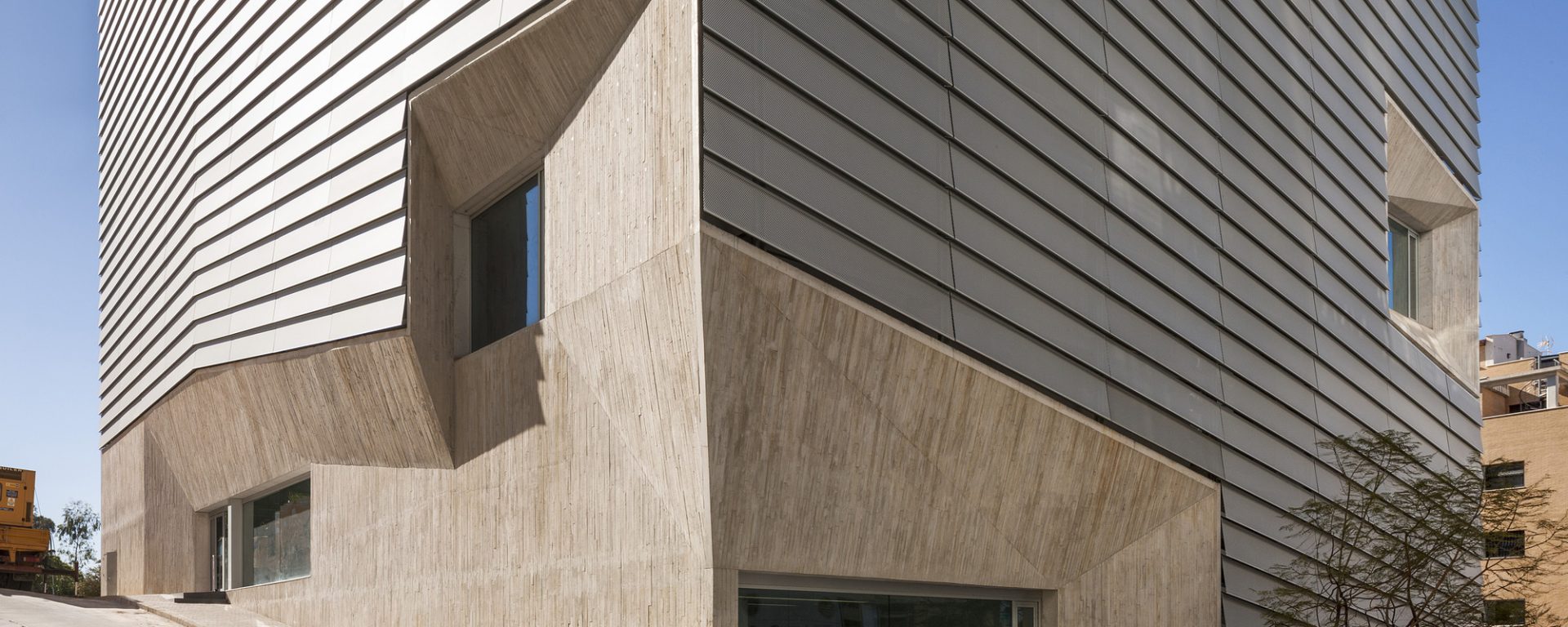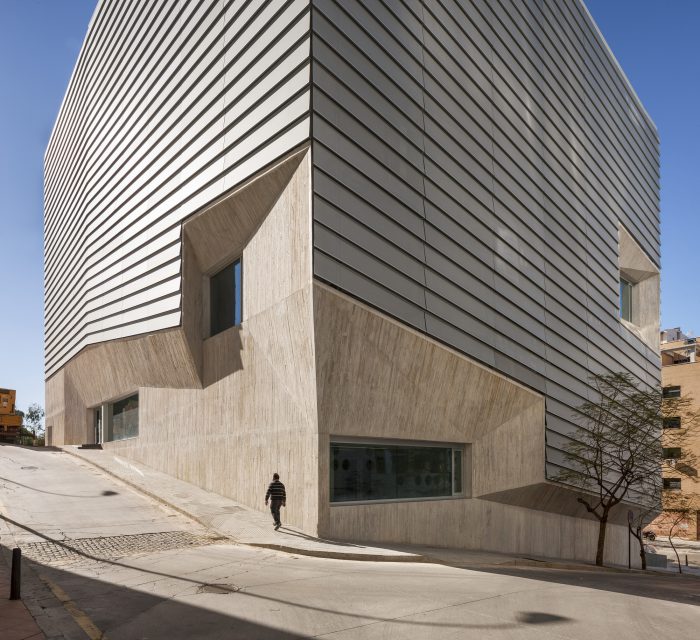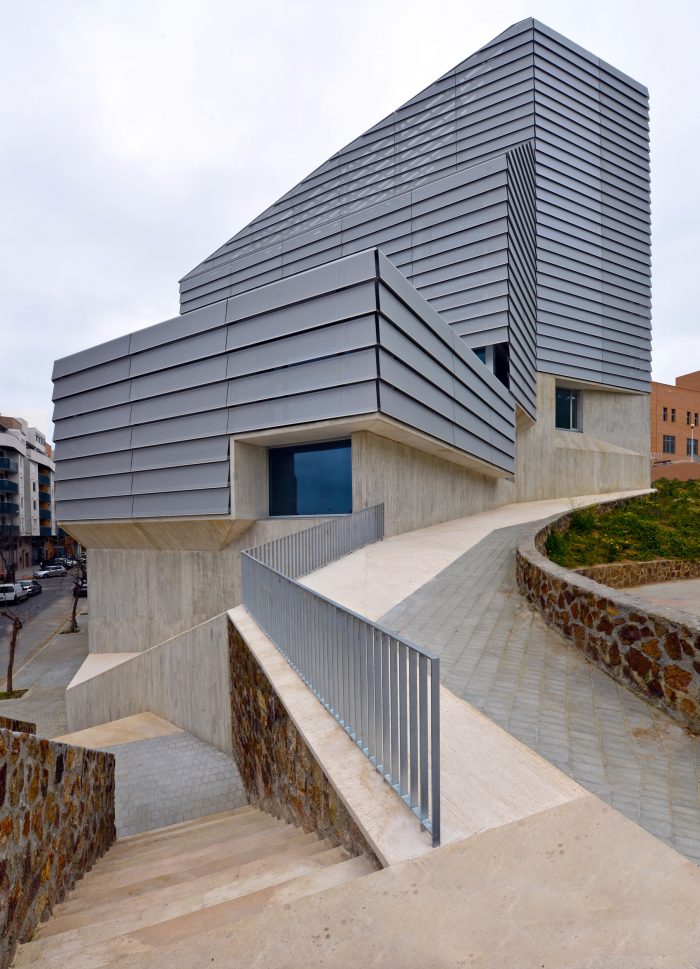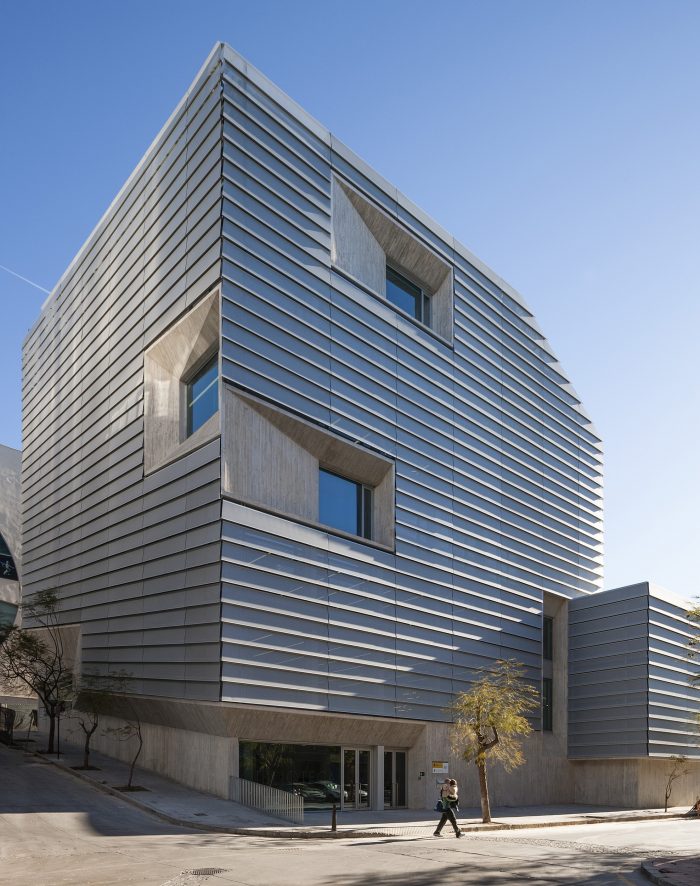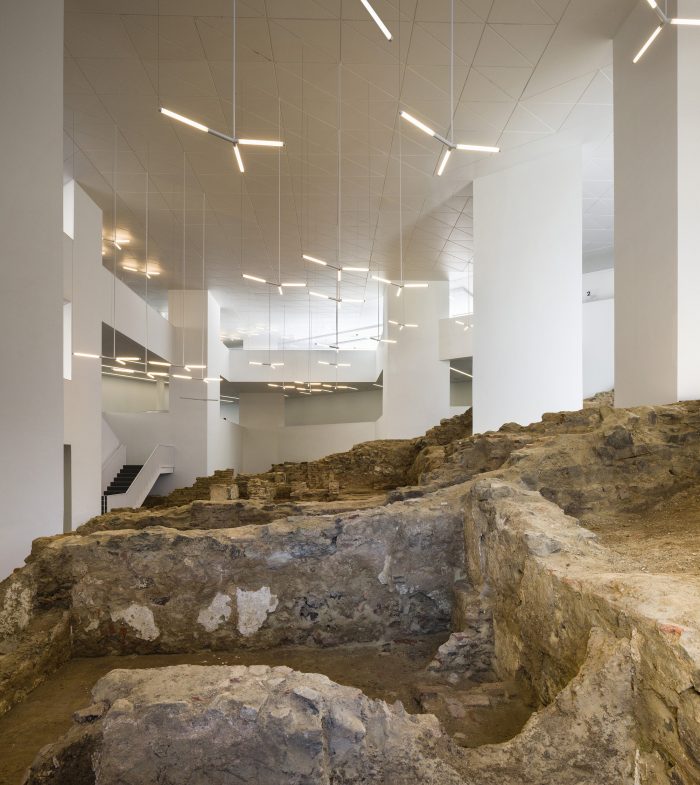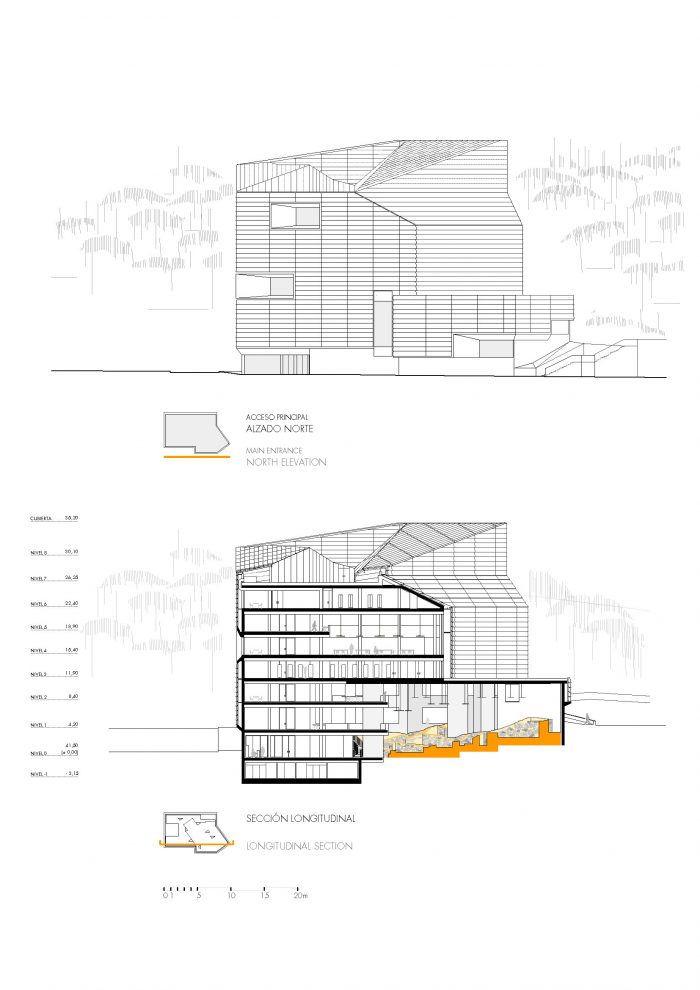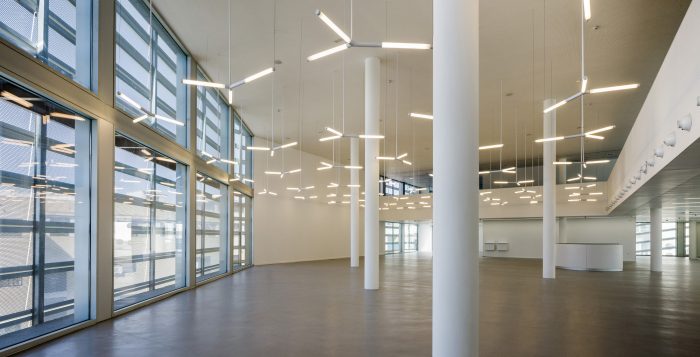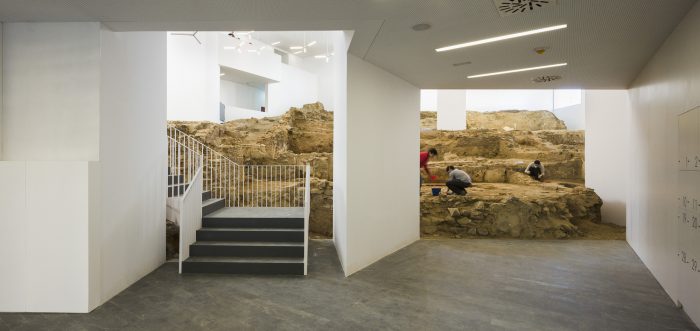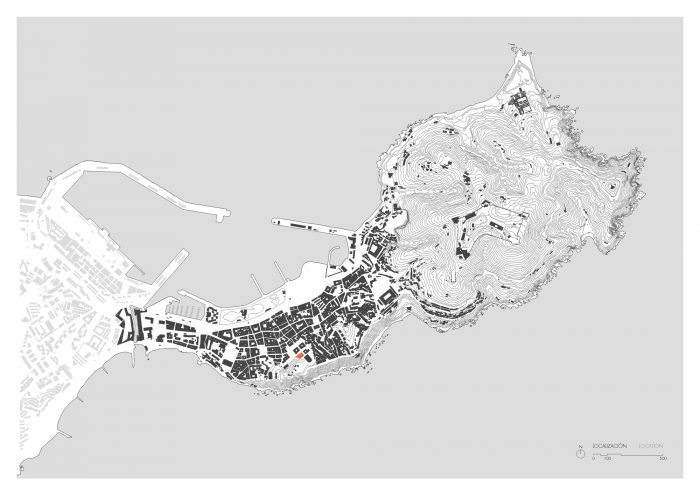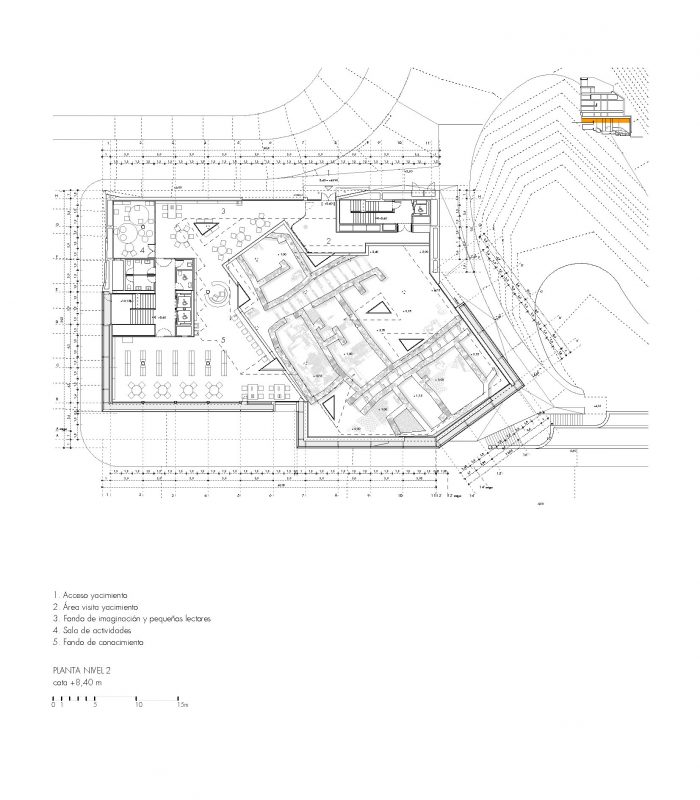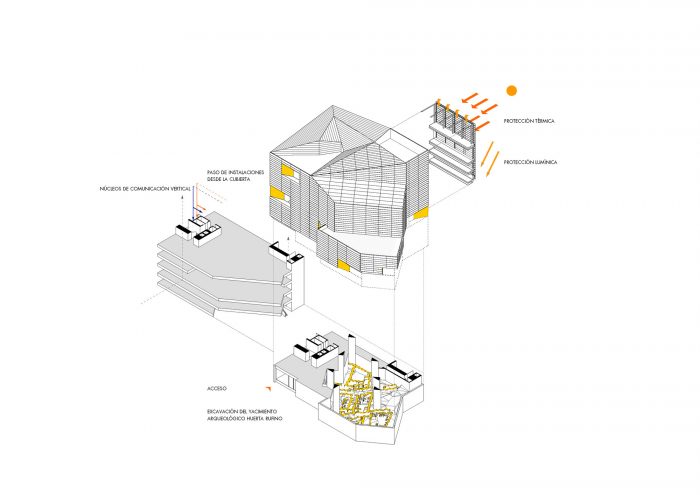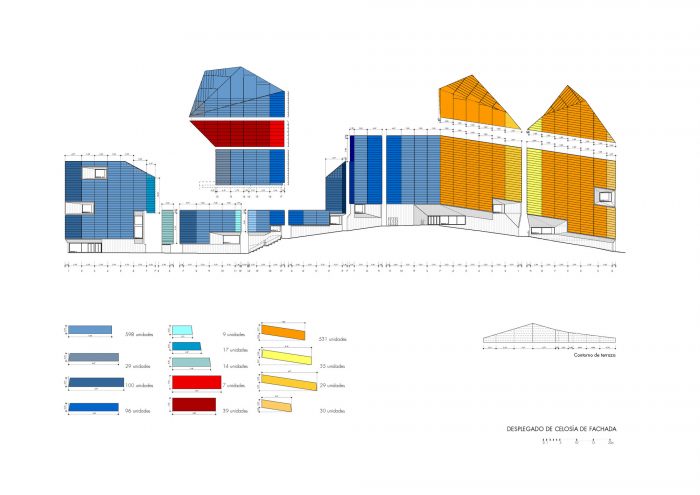休达新图书馆的条件是该地块的陡峭地形和十四世纪阿拉伯马利尼德人的考古挖掘,这决定了图书馆的所有内部空间。休达是西班牙的一个自治城市,位于地中海和大西洋交界处的非洲北岸,其空间的匮乏和紧凑性也制约了这一提议。
这个古老的居住区的正交几何学是从实际的城市网格中转过来的。这一事实为考古遗址上的结构建立了一个三角形的几何形状,阿拉伯城市的城市价值被纳入新建筑的几何形状中。
The new Library in Ceuta is conditioned by the steep topography of the plot and by the Arab Marinid archaeological excavation of the XIV century that determine all interior spaces of the Library. Also the lack of space and the compactness of Ceuta, an autonomous Spanish city located on the north coast of Africa on the border of the Mediterranean Sea and the Atlantic Ocean, condition the proposal.
The orthogonal geometry of this ancient settlement is turned from that of the actual urban grid. This fact establishes a triangular geometry for the structure over the archaeological site and the urban value of the Arab city is included in the geometry of new building.
图书馆被设想为一个紧凑的体量,保留了考古区域作为公共空间的核心,在阅读空间和Marinid中心的游客之间创造了一种开放和透明的感觉。图书馆被安排在斜坡上的梯田中,拥抱着过去的遗迹。讲座室堆叠在几个层次上,俯瞰着空旷的地方,在那里,悬挂的三角形灯组与两个几何形状的山峰都设置在考古中心的上空。两层中的两个不同的入口,一个通向图书馆,另一个通向游客中心,将内部与附近的街道连接起来。
七根三角形的混凝土柱子支撑着建筑,其程序是垂直组织的。第三层是一般的图书展示区,位于覆盖考古遗址的混凝土结构之上。在它之上,一个轻钢结构在六个层次上堆叠的程序是最高的一个书库,档案馆和办公室。
The Library is conceived as a compact volume that preserves the archaeological area as the core of the public spaces, creating a sense of openness and transparency between reading spaces and visitors to the Marinid centre. The library is organized in terraces placed on the slope that embrace the remains of the past. The lecture rooms are stacked in several levels overlooking the void where groups of hanging triangular lamps with peaks in both geometries are set over the archaeological centre. Two different entrances in two levels, one to the Library and other to the visitors centre, are placed linking the inside to the nearby streets.
Seven triangular concrete pillars support the building with a program organized vertically. The third floor with the general book display is placed over the concrete structure that covers the archaeological site. Over it a light steel structure in six levels stacks the program being the highest one the book depot, archives and offices.
紧凑的折叠体完全被铝制穿孔表皮所包裹,减少了眩光和太阳辐射,最大限度地利用了自然光,降低了长期的能源成本。这种网状结构减轻了日光的刺眼性,从而最大限度地减少了人工光的使用,避免了对比,并有助于照亮空间的深度。最终的外墙包括不同的玻璃金属层,节能:内部的玻璃层和外部的金属层,作为面纱,与不断变化的光照条件相互作用,保护内部免受阳光和热量的影响。在不同的方向上,玻璃板的组成略有不同,为图书馆提供了一个差异化而又统一的表皮,强调了建筑的多面形状。在它们之间有一条廊道,便于维护玻璃开口和简单的安装。
The compact folded volume is entirely wrapped up in an aluminium-perforated skin that reduces glare and solar gain and maximises the use of natural daylight reducing long-term energy costs. The mesh mitigates the sometimes-harsh qualities of daylight thus minimising the use of artificial light to avoid contrast and helping to illuminate the depth of the space. The final façade includes different glass-metal layers, energy efficient: an interior glass one and an outer metal one, as a veil, that interplay with the changing light conditions protecting the inside from the sun and heat. Slight variations in the make up of the panels, for different orientations, provide the library with a differentiated yet uniform skin, emphasizing the faceted shape of the building. Between them a gallery permits easy maintenance of glass openings and simple installations.
混凝土铺设的地下室沿着陡峭的街道延伸,在图书馆的双立面上开辟了几个混凝土结构的空隙,作为朝向城市的视点。在屋顶层的平台上,放置了一个开放的阅览室,由包裹建筑的铝制穿孔表皮遮挡,过滤阳光,并向海洋、欧洲和非洲开放。
A concrete plied basement runs along the steep streets and several concrete structural voids are cut up in the double façade of the Library as viewpoints towards the city. On the terrace in the roof level an open reading room is placed, shaded by the aluminium-perforated skin that wraps up the building that filters sun and open views towards both seas, Europe and Africa.
建筑师:Paredes Pedrosa
面积:6159平方米
年份:2013年
照片:Fernando Alda, Manuel García de Paredes
制造商:panoramah!®
合作者:Lucía Guadalajara, Álvaro Rábano, Clemens Eichner, Álvaro Oliver, Guiomar Martín, Eva Urquijo, Ángel Camacho, Ignacio Cordero, Blanca Leal, Roberto Lebrero, Luis Calvo
技术控制:Juan Antonio Zoido
结构:Alfonso Gómez Gaite. GOGAITE, S.L.
安装:JG Ingenieros S.A.
客户:Ministerio de Cultura, Educación y Deporte
建筑师:Ángela García de Paredes,Ignacio Pedrosa
城市:Ceuta
国家:西班牙
Architects: Paredes Pedrosa
Area: 6159 m²
Year: 2013
Photographs: Fernando Alda, Manuel García de Paredes
Manufacturers: panoramah!®
Collaborators:Lucía Guadalajara, Álvaro Rábano, Clemens Eichner, Álvaro Oliver, Guiomar Martín, Eva Urquijo, Ángel Camacho, Ignacio Cordero, Blanca Leal, Roberto Lebrero, Luis Calvo
Technical Control:Juan Antonio Zoido
Structure:Alfonso Gómez Gaite. GOGAITE, S.L.
Installations:JG Ingenieros S.A.
Client:Ministerio de Cultura, Educación y Deporte
Architect In Charge:Ángela García de Paredes, Ignacio Pedrosa
City:Ceuta
Country:Spain

